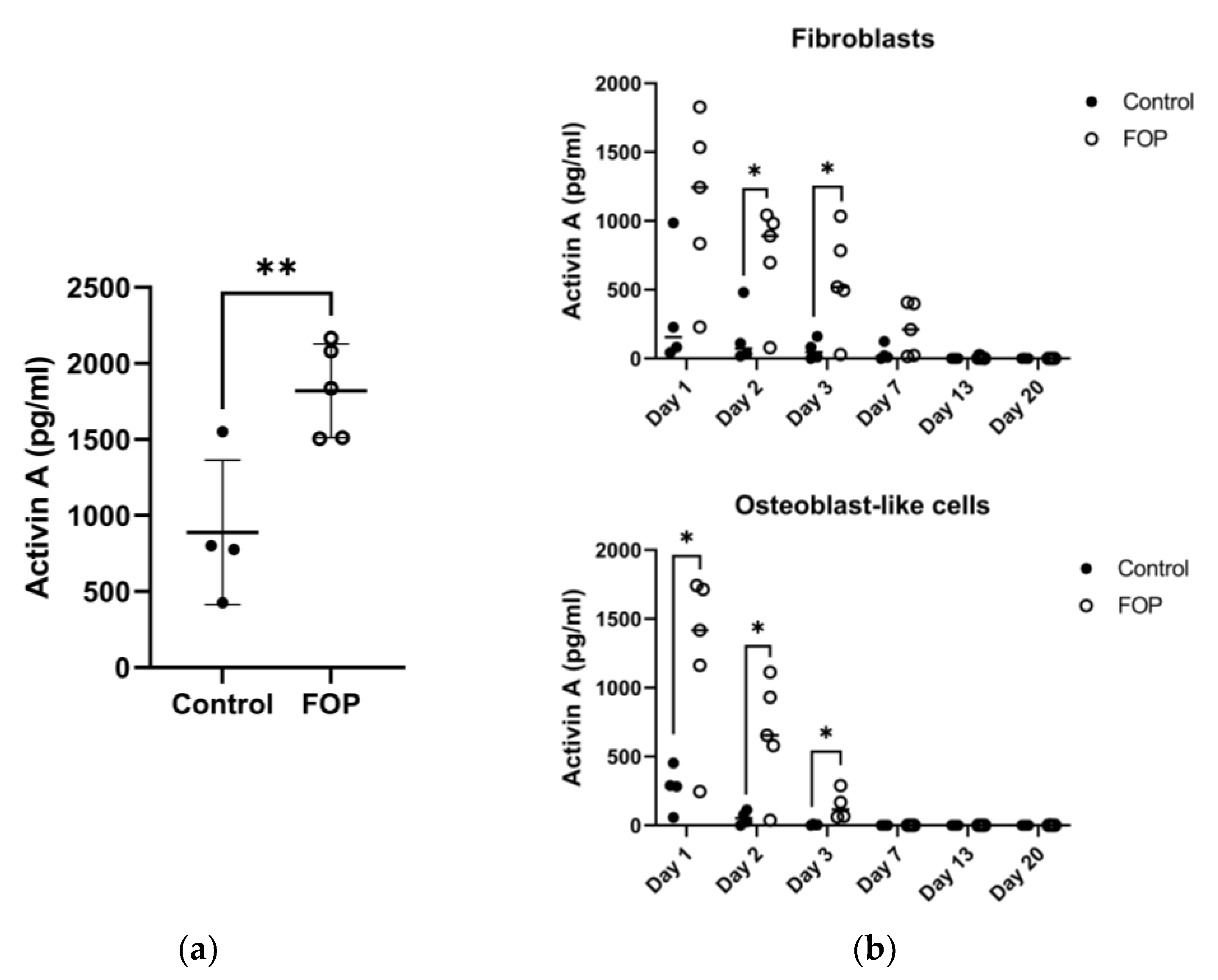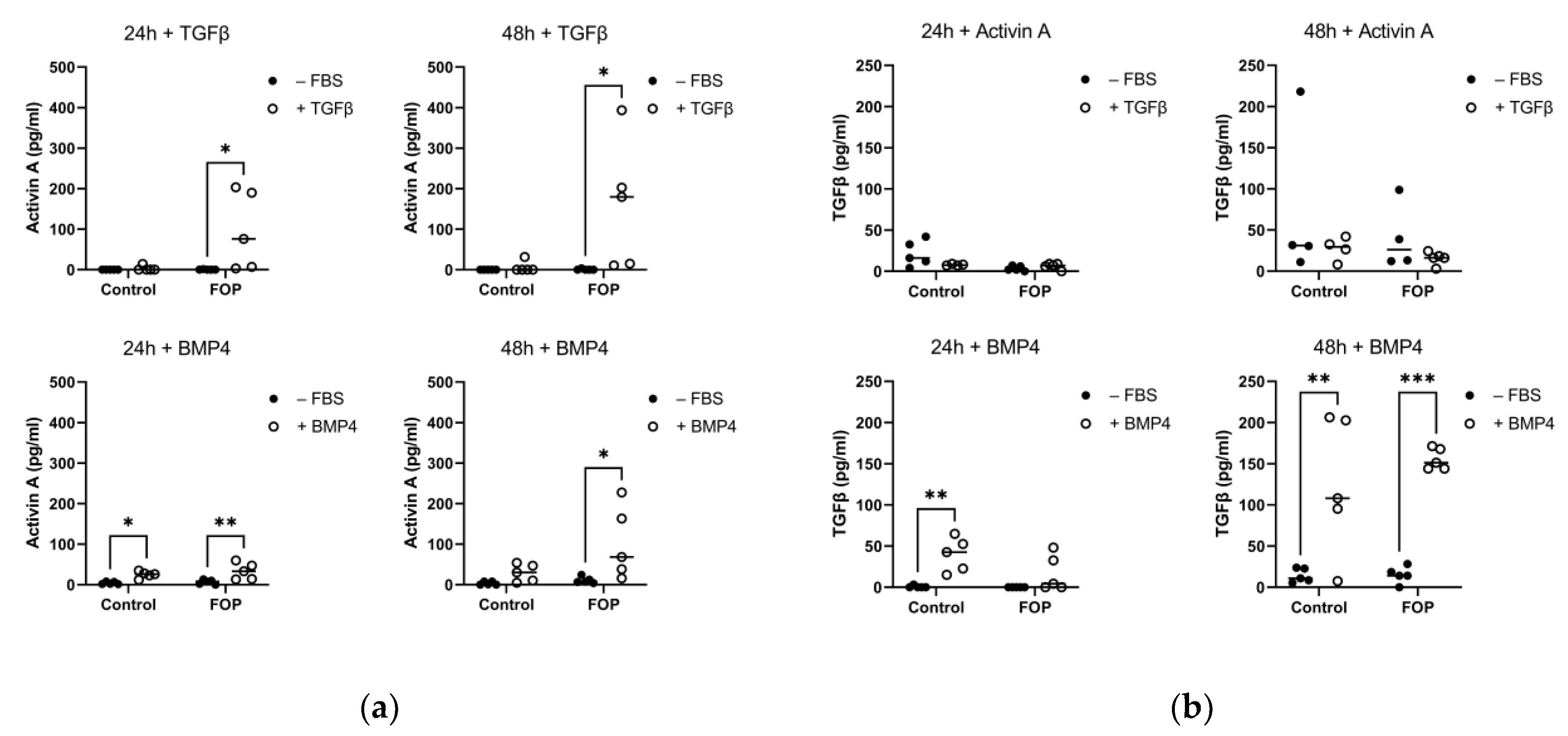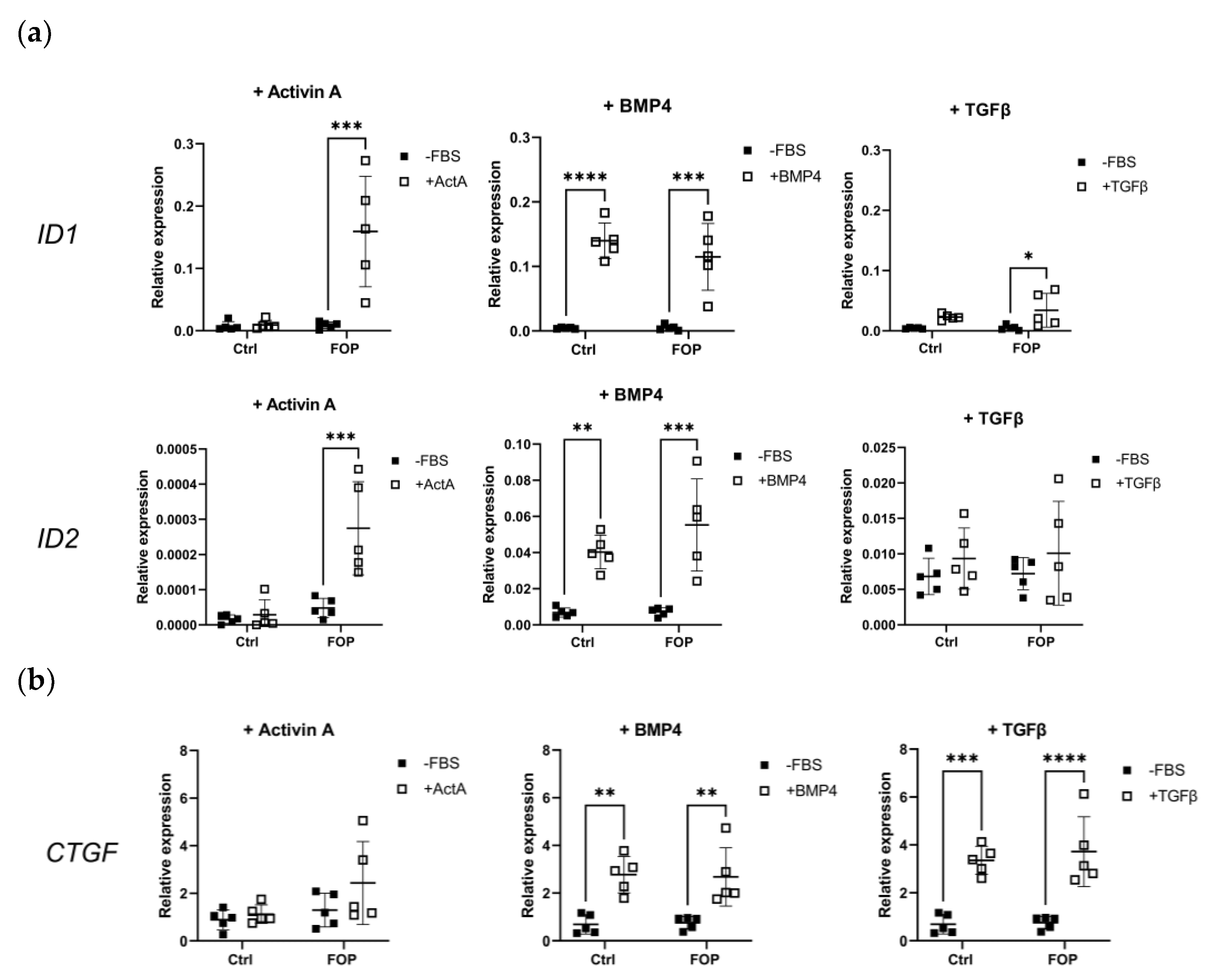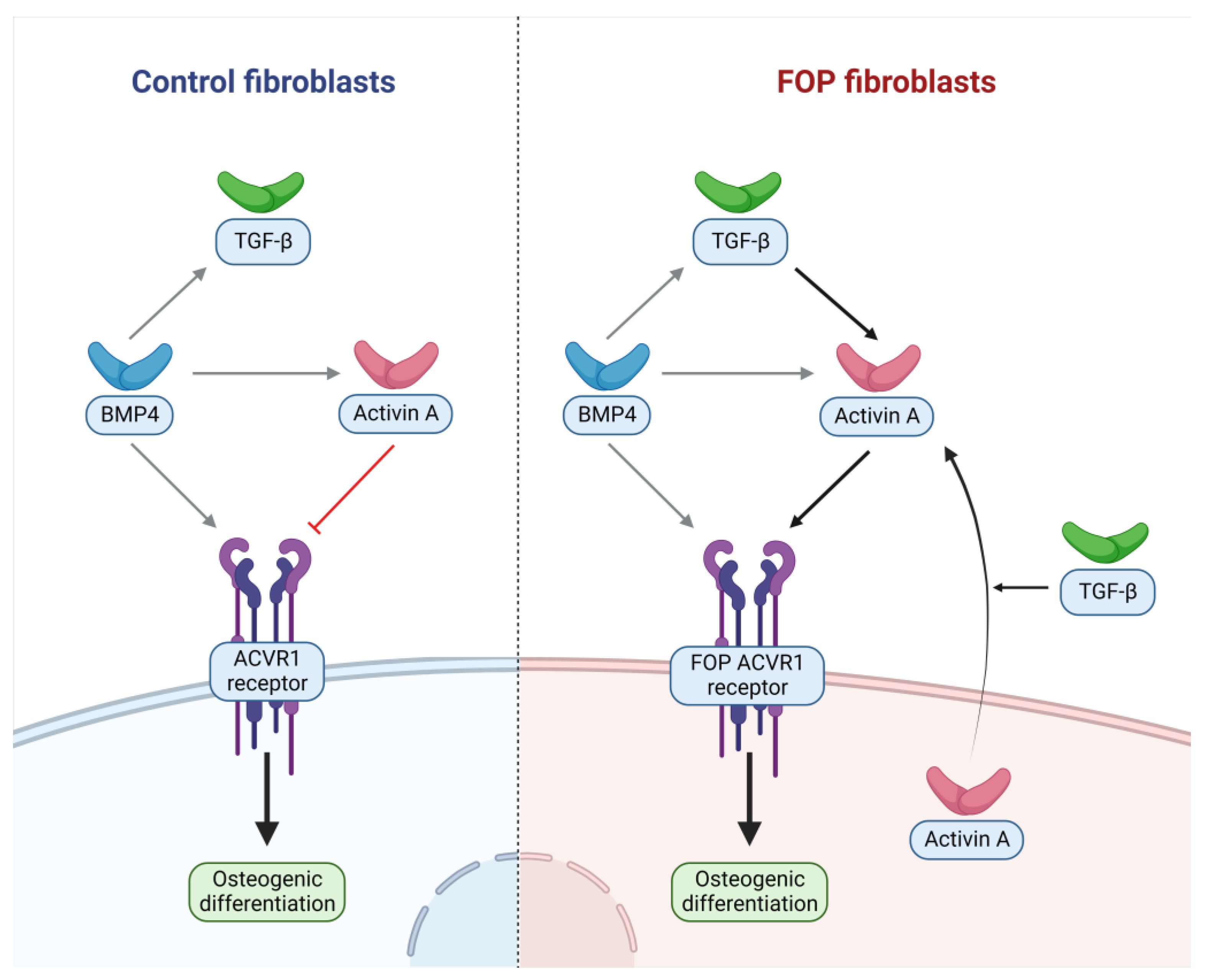TGF-Beta Induces Activin A Production in Dermal Fibroblasts Derived from Patients with Fibrodysplasia Ossificans Progressiva
Abstract
:1. Introduction
2. Results
2.1. SMAD Signalling in Fibroblasts of FOP Patients
2.2. Activin A Production by FOP Fibroblasts
2.3. Cytokine Regulation of Activin A Production by FOP Fibroblasts
2.4. Expression of BMP and TGFβ Target Genes
2.5. Gene Expression of Cytokines in Fibroblasts
3. Discussion
4. Materials and Methods
4.1. Clinical Characteristics of FOP Patients
4.2. Cell Culture
4.3. DNA Analysis of Fibroblasts
4.4. ELISA Analysis
4.5. RNA Isolation, cDNA Synthesis and qPCR
4.6. Protein Isolation and Western Blotting Analysis
4.7. Statistics
Supplementary Materials
Author Contributions
Funding
Institutional Review Board Statement
Informed Consent Statement
Data Availability Statement
Conflicts of Interest
Abbreviations
| ACVR1 | Activin receptor 1 |
| ALP | Alkaline phosphatase |
| ALK2 | Activin-like kinase 2 |
| COL1A1 | Collagen, type 1, alpha 1 |
| CTGF | Connective tissue growth factor |
| DLX1 | Distal-less homeobox 1 |
| ELISA | Enzyme-linked immunosorbent assay |
| EMA | European Medicines Agency |
| FAP | Fibroadipogenic progenitor |
| FBS | Fetal bovine serum |
| FOP | Fibrodysplasia ossificans progressiva |
| FDA | Federal Drug Authority |
| HO | Heterotopic ossification |
| ID1 | Inhibitor of DNA binding 1 |
| ID2 | Inhibitor of DNA binding 2 |
| IL1b | Interleukin-1 beta |
| IL6 | Interleukin-6 |
| INHBA | Inhibin A |
| MSX2 | Msh homeobox 2 |
| RUNX2 | Runt-related transcription factor 2 |
| TGFβ | Transforming growth factor beta |
| TGFβR1 | Transforming growth factor beta receptor 1 |
| TGFβR2 | Transforming growth factor beta receptor 2 |
| THBS1 | Thrombospondin 1 |
| TNFα | Tumor necrosis factor alpha |
| YWHAZ | YWHAZ housekeeping gene |
References
- Pignolo, R.J.; Shore, E.M.; Kaplan, F.S. Fibrodysplasia Ossificans Progressiva: Clinical and Genetic Aspects. Orphanet J. Rare Dis. 2011, 6, 80. [Google Scholar] [CrossRef] [PubMed] [Green Version]
- Shen, Q.; Little, S.C.; Xu, M.; Haupt, J.; Ast, C.; Katagiri, T.; Mundlos, S.; Seemann, P.; Kaplan, F.S.; Mullins, M.C.; et al. The fibrodysplasia ossificans progressiva R206H ACVR1 mutation activates BMP-independent chondrogenesis and zebrafish embryo ventralization. J. Clin. Investig. 2009, 119, 3462–3472. [Google Scholar] [CrossRef] [PubMed] [Green Version]
- Lees-Shepard, J.B.; Yamamoto, M.; Biswas, A.A.; Stoessel, S.J.; Nicholas, S.-A.E.; Cogswell, C.A.; Devarakonda, P.M.; Schneider, M.J., Jr.; Cummins, S.M.; Legendre, N.P.; et al. Activin-dependent signaling in fibro/adipogenic progenitors causes fibrodysplasia ossificans progressiva. Nat. Commun. 2018, 9, 471. [Google Scholar] [CrossRef] [PubMed] [Green Version]
- Shore, E.M.; Xu, M.; Feldman, G.J.; A Fenstermacher, D.; Cho, T.-J.; Choi, I.H.; Connor, J.M.; Delai, P.; Glaser, D.L.; LeMerrer, M.; et al. A recurrent mutation in the BMP type I receptor ACVR1 causes inherited and sporadic fibrodysplasia ossificans progressiva. Nat. Genet. 2006, 38, 525–527. [Google Scholar] [CrossRef]
- Al Kaissi, A.; Kenis, V.; Ghachem, M.B.; Hofstaetter, J.; Grill, F.; Ganger, R.; Kircher, S.G. The diversity of the clinical phenotypes in patients with fibrodysplasia ossificans progressiva. J. Clin. Med. Res. 2016, 8, 246. [Google Scholar] [CrossRef] [Green Version]
- Pignolo, R.J.; Bedford-Gay, C.; Liljesthröm, M.; Durbin-Johnson, B.P.; Shore, E.M.; Rocke, D.M.; Kaplan, F.S. The Natural History of Flare-Ups in Fibrodysplasia Ossificans Progressiva (FOP): A Comprehensive Global Assessment. J. Bone Miner. Res. 2015, 31, 650–656. [Google Scholar] [CrossRef] [Green Version]
- Convente, M.R.; Chakkalakal, S.A.; Yang, E.; Caron, R.J.; Zhang, D.; Kambayashi, T.; Kaplan, F.S.; Shore, E.M. Depletion of mast cells and macrophages impairs heterotopic ossification in an Acvr1R206H mouse model of fibrodysplasia ossificans progressiva. J. Bone Miner. Res. 2018, 33, 269–282. [Google Scholar] [CrossRef] [Green Version]
- Pignolo, R.J.; McCarrick-Walmsley, R.; Wang, H.; Qiu, S.; Hunter, J.; Barr, S.; He, K.; Zhang, H.; Kaplan, F.S. Plasma-Soluble Biomarkers for Fibrodysplasia Ossificans Progressiva (FOP) Reflect Acute and Chronic Inflammatory States. J. Bone Miner. Res. 2022, 37, 475–483. [Google Scholar] [CrossRef]
- Matsuo, K.; Chavez, R.D.; Barruet, E.; Hsiao, E.C. Inflammation in Fibrodysplasia Ossificans Progressiva and Other Forms of Heterotopic Ossification. Curr. Osteoporos. Rep. 2019, 17, 387–394. [Google Scholar] [CrossRef]
- Haviv, R.; Moshe, V.; De Benedetti, F.; Prencipe, G.; Rabinowicz, N.; Uziel, Y. Is fibrodysplasia ossificans progressiva an interleukin-1 driven auto-inflammatory syndrome? Pediatr. Rheumatol. Online J. 2019, 17, 84. [Google Scholar] [CrossRef]
- Hwang, C.; Pagani, C.; Das, N.; Marini, S.; Huber, A.K.; Xie, L.; Jimenez, J.; Brydges, S.; Lim, W.K.; Nannuru, K.C.; et al. Activin A does not drive post-traumatic heterotopic ossification. Bone 2020, 138, 115473. [Google Scholar] [CrossRef]
- Chen, W.; Dijke, P.T. Immunoregulation by members of the TGFβ superfamily. Nat. Rev. Immunol. 2016, 16, 723–740. [Google Scholar] [CrossRef]
- Chen, Y.G.; Liu, F.; Massague, J. Mechanism of TGFbeta receptor inhibition by FKBP12. EMBO J. 1997, 16, 3866–3876. [Google Scholar] [CrossRef]
- Groppe, J.C.; Wu, J.; Shore, E.M.; Kaplan, F.S. In vitro analyses of the dysregulated R206H ALK2 kinase-FKBP12 interaction asso-ciated with heterotopic ossification in FOP. Cells Tissues Organs. 2011, 194, 291–295. [Google Scholar] [CrossRef] [Green Version]
- Matsumoto, Y.; Hayashi, Y.; Schlieve, C.R.; Ikeya, M.; Kim, H.; Nguyen, T.D.; Sami, S.; Baba, S.; Barruet, E.; Nasu, A.; et al. Induced pluripotent stem cells from patients with human fibrodysplasia ossificans progressiva show increased mineralization and cartilage formation. Orphanet J. Rare Dis. 2013, 8, 190. [Google Scholar] [CrossRef] [Green Version]
- Hildebrand, L.; Stange, K.; Deichsel, A.; Gossen, M.; Seemann, P. The Fibrodysplasia Ossificans Progressiva (FOP) mutation p.R206H in ACVR1 confers an altered ligand response. Cell. Signal. 2017, 29, 23–30. [Google Scholar] [CrossRef] [Green Version]
- Hatsell, S.J.; Idone, V.; Wolken, D.M.A.; Huang, L.; Kim, H.J.; Wang, L.; Wen, X.; Nannuru, K.C.; Jimenez, J.; Xie, L.; et al. ACVR1R206H receptor mutation causes fibrodysplasia ossificans progressiva by imparting responsiveness to activin A. Sci. Transl. Med. 2015, 7, 303ra137. [Google Scholar] [CrossRef]
- Upadhyay, J.; Xie, L.; Huang, L.; Das, N.; Stewart, R.C.; Lyon, M.C.; Palmer, K.; Rajamani, S.; Graul, C.; Lobo, M.; et al. The expansion of heterotopic bone in fibrodysplasia ossificans progressiva is activin A-dependent. J. Bone Miner. Res. 2017, 32, 2489–2499. [Google Scholar] [CrossRef] [Green Version]
- Micha, D.; Voermans, E.; Eekhoff, M.E.; van Essen, H.W.; Zandieh-Doulabi, B.; Netelenbos, C.; Rustemeyer, T.; Sistermans, E.; Pals, G.; Bravenboer, N. Inhibition of TGFβ signaling decreases osteogenic differentiation of fibrodysplasia ossificans progressiva fibroblasts in a novel in vitro model of the disease. Bone 2016, 84, 169–180. [Google Scholar] [CrossRef]
- Cayami, F.K.; Claeys, L.; de Ruiter, R.; Smilde, B.J.; Wisse, L.; Bogunovic, N.; Riesebos, E.; Eken, L.; Kooi, I.; Sistermans, E.A.; et al. Osteogenic transdifferentiation of primary human fibroblasts to osteoblast-like cells with human platelet lysate. Sci. Rep. 2022, 12, 14686. [Google Scholar] [CrossRef]
- Lewis, T.C.; Prywes, R. Serum regulation of Id1 expression by a BMP pathway and BMP responsive element. Biochim. et Biophys. Acta (BBA) Gene Regul. Mech. 2013, 1829, 1147–1159. [Google Scholar] [CrossRef] [PubMed] [Green Version]
- Wu, D.H.; Hatzopoulos, A.K. Bone morphogenetic protein signaling in inflammation. Exp. Biol. Med. 2019, 244, 147–156. [Google Scholar] [CrossRef] [PubMed] [Green Version]
- Barruet, E.; Morales, B.M.; Cain, C.J.; Ton, A.N.; Wentworth, K.L.; Chan, T.V.; Moody, T.A.; Haks, M.C.; Ottenhoff, T.H.; Hellman, J.; et al. NF-κB/MAPK activation underlies ACVR1-mediated inflammation in human heterotopic ossification. JCI Insight. 2018, 3, e122958. [Google Scholar] [CrossRef] [PubMed] [Green Version]
- Wang, X.; Li, F.; Xie, L.; Crane, J.; Zhen, G.; Mishina, Y.; Deng, R.; Gao, B.; Chen, H.; Liu, S.; et al. Inhibition of overactive TGF-β attenuates progression of heterotopic ossification in mice. Nat. Commun. 2018, 9, 551. [Google Scholar] [CrossRef] [Green Version]
- Hino, K.; Ikeya, M.; Horigome, K.; Matsumoto, Y.; Ebise, H.; Nishio, M.; Sekiguchi, K.; Shibata, M.; Nagata, S.; Matsuda, S.; et al. Neofunction of ACVR1 in fibrodysplasia ossificans progressiva. Proc. Natl. Acad. Sci. USA 2015, 112, 15438–15443. [Google Scholar] [CrossRef] [Green Version]
- Matsuo, K.; Lepinski, A.; Chavez, R.D.; Barruet, E.; Pereira, A.; Moody, T.A.; Ton, A.N.; Sharma, A.; Hellman, J.; Tomoda, K.; et al. ACVR1R206H extends inflammatory responses in human induced pluripotent stem cell-derived macrophages. Bone 2021, 153, 116129. [Google Scholar] [CrossRef]
- Chang, H.Y.; Chi, J.T.; Dudoit, S.; Bondre, C.; van de Rijn, M.; Botstein, D.; Brown, P.O. Diversity, topographic differentiation, and positional memory in human fibroblasts. Proc. Natl. Acad. Sci. USA 2002, 99, 12877–12882. [Google Scholar] [CrossRef] [Green Version]
- Gannon, F.H.; Valentine, B.A.; Shore, E.M.; Zasloff, M.A.; Kaplan, F.S. Acute Lymphocytic Infiltration in an Extremely Early Lesion of Fibrodysplasia Ossificans Progressiva. Clin. Orthop. Relat. Res. 1998, 346, 19–25. [Google Scholar] [CrossRef]
- Gannon, F.H.; Glaser, D.; Caron, R.; Thompson, L.D.; Shore, E.M.; Kaplan, F.S. Mast cell involvement in fibrodysplasia ossificans progressiva. Hum. Pathol. 2001, 32, 842–848. [Google Scholar] [CrossRef] [Green Version]
- Morianos, I.; Papadopoulou, G.; Semitekolou, M.; Xanthou, G. Activin-A in the regulation of immunity in health and disease. J. Autoimmun. 2019, 104, 102314. [Google Scholar] [CrossRef]
- Chakkalakal, S.A.; Zhang, D.; Culbert, A.L.; Convente, M.R.; Caron, R.J.; Wright, A.C.; Maidment, A.D.; Kaplan, F.S.; Shore, E.M. An Acvr1 R206H knock-in mouse has fibrodysplasia ossificans progressiva. J. Bone Miner. Res. 2012, 27, 1746–1756. [Google Scholar] [CrossRef] [Green Version]
- Mundy, C.; Yao, L.; Sinha, S.; Chung, J.; Rux, D.; Catheline, S.E.; Koyama, E.; Qin, L.; Pacifici, M. Activin A promotes the development of acquired heterotopic ossification and is an effective target for disease attenuation in mice. Sci. Signal. 2021, 14, eabd0536. [Google Scholar] [CrossRef]
- Rokavec, M.; Öner, M.G.; Hermeking, H. lnflammation-induced epigenetic switches in cancer. Cell. Mol. Life Sci. 2015, 73, 23–39. [Google Scholar] [CrossRef]
- Lichtman, M.K.; Otero-Vinas, M.; Falanga, V. Transforming growth factor beta (TGF-β) isoforms in wound healing and fibrosis. Wound Repair Regen. 2016, 24, 215–222. [Google Scholar] [CrossRef]
- Kaplan, F.S.; Shore, E.M.; Gupta, R.; Billings, P.C.; Glaser, D.L.; Pignolo, R.J.; Graf, D.; Kamoun, M. Immunological features of fibrodysplasia ossificans progressiva and the dysregulated BMP4 pathway. Clin. Rev. Bone Miner. Metab. 2005, 3, 189–193. [Google Scholar] [CrossRef]
- Teixeira, A.F.; Ten Dijke, P.; Zhu, H.J. On-target anti-TGF-β therapies are not succeeding in clinical cancer treatments: What are remaining challenges? Front. Cell Dev. Biol. 2020, 8, 605. [Google Scholar] [CrossRef]
- Song, I.-W.; Nagamani, S.C.; Nguyen, D.; Grafe, I.; Sutton, V.R.; Gannon, F.H.; Munivez, E.; Jiang, M.-M.; Tran, A.; Wallace, M.; et al. Targeting TGF-β for treatment of osteogenesis imperfecta. J. Clin. Investig. 2022, 132, e152571. [Google Scholar] [CrossRef]
- Meng, X.-M.; Huang, X.R.; Xiao, J.; Chen, H.-Y.; Zhong, X.; Chung, A.C.; Lan, H.Y. Diverse roles of TGF-β receptor II in renal fibrosis and inflammation in vivo and in vitro. J. Pathol. 2012, 227, 175–188. [Google Scholar] [CrossRef]
- Yang, Y.A.; Dukhanina, O.; Tang, B.; Mamura, M.; Letterio, J.J.; MacGregor, J.; Patel, S.C.; Khozin, S.; Liu, Z.Y.; Green, J.; et al. Lifetime exposure to a soluble TGF-β antagonist protects mice against metastasis without adverse side effects. J. Clin. Investig. 2002, 109, 1607–1615. [Google Scholar] [CrossRef]






| Gender | Age at biopsy | Flare-Up < 1 Week Prior to Biopsy | Medication Used During Biopsy | |
|---|---|---|---|---|
| Patient 1 | Male | 23.2 | No | - |
| Patient 2 | Female | 21.9 | Yes | Celecoxib |
| Patient 3 | Male | 62.4 | No | - |
| Patient 4 | Male | 14.8 | Yes | Naproxen |
| Patient 5 | Female | 39.6 | Yes | Tramadol |
| Gene | NM Number | Sequence |
|---|---|---|
| ID1 | NM_002165 | AATCCGAAGTTGGAACCCCC |
| AACGCATGCCGCCTCG | ||
| ID2 | NM_002166 | GTGGCTGAATAAGCGGTGTTC |
| CTGGTATTCACGCTCCACCT | ||
| DLX1 | NM_178120 | GACTCACACAGACTCAGGTCAA |
| AGCGGGTTTATCTTGCTGCT | ||
| MSX2 | NM_002449 | TCATGGCTTCTCCGTCCAAA |
| AGGGCTCATATGTCTTGGCG | ||
| CTGF | NM_001901 | ATTCTGTCACTTCGGCTCCC |
| TCCAGTCGGTAAGCCGC | ||
| COL1A1 | NM_000088 | GTGCTAAAGGTGCCAATGGT |
| ACCAGGTTCACCGCTGTTAC | ||
| THBS1 | NM_003246 | CTCAGGAACAAAGGCTGCTC |
| TGGACAGCTCATCACAGGAG | ||
| INHBA | NM_002192 | GTTTGCCGAGTCAGGAACAG |
| TCACAGGCAATCCGAACGTC | ||
| TGFβR1 | NM_000660 | CCGACTACTACGCCAAGGAG |
| GGTATCGCCAGGAATTGTTG | ||
| IL6 | NM_001371096 | AGTTCCTGCAGAAAAAGGCAAAG |
| AAGCTGCGCAGAATGAGATGA | ||
| IL1b | NM_000576 | AGCCATGGCAGAAGTACCTG |
| CCTGGAAGGAGCACTTCATCT | ||
| YWHAZ | NM_001135701.2 | GATGAAGCCATTGCTGAACTTG |
| CTATTTGTGGGACAGCATGGA |
Disclaimer/Publisher’s Note: The statements, opinions and data contained in all publications are solely those of the individual author(s) and contributor(s) and not of MDPI and/or the editor(s). MDPI and/or the editor(s) disclaim responsibility for any injury to people or property resulting from any ideas, methods, instructions or products referred to in the content. |
© 2023 by the authors. Licensee MDPI, Basel, Switzerland. This article is an open access article distributed under the terms and conditions of the Creative Commons Attribution (CC BY) license (https://creativecommons.org/licenses/by/4.0/).
Share and Cite
de Ruiter, R.D.; Wisse, L.E.; Schoenmaker, T.; Yaqub, M.; Sánchez-Duffhues, G.; Eekhoff, E.M.W.; Micha, D. TGF-Beta Induces Activin A Production in Dermal Fibroblasts Derived from Patients with Fibrodysplasia Ossificans Progressiva. Int. J. Mol. Sci. 2023, 24, 2299. https://doi.org/10.3390/ijms24032299
de Ruiter RD, Wisse LE, Schoenmaker T, Yaqub M, Sánchez-Duffhues G, Eekhoff EMW, Micha D. TGF-Beta Induces Activin A Production in Dermal Fibroblasts Derived from Patients with Fibrodysplasia Ossificans Progressiva. International Journal of Molecular Sciences. 2023; 24(3):2299. https://doi.org/10.3390/ijms24032299
Chicago/Turabian Stylede Ruiter, Ruben D., Lisanne E. Wisse, Ton Schoenmaker, Maqsood Yaqub, Gonzalo Sánchez-Duffhues, E. Marelise W. Eekhoff, and Dimitra Micha. 2023. "TGF-Beta Induces Activin A Production in Dermal Fibroblasts Derived from Patients with Fibrodysplasia Ossificans Progressiva" International Journal of Molecular Sciences 24, no. 3: 2299. https://doi.org/10.3390/ijms24032299
APA Stylede Ruiter, R. D., Wisse, L. E., Schoenmaker, T., Yaqub, M., Sánchez-Duffhues, G., Eekhoff, E. M. W., & Micha, D. (2023). TGF-Beta Induces Activin A Production in Dermal Fibroblasts Derived from Patients with Fibrodysplasia Ossificans Progressiva. International Journal of Molecular Sciences, 24(3), 2299. https://doi.org/10.3390/ijms24032299






